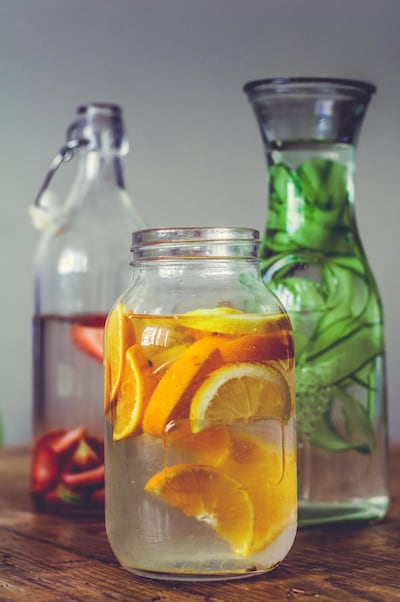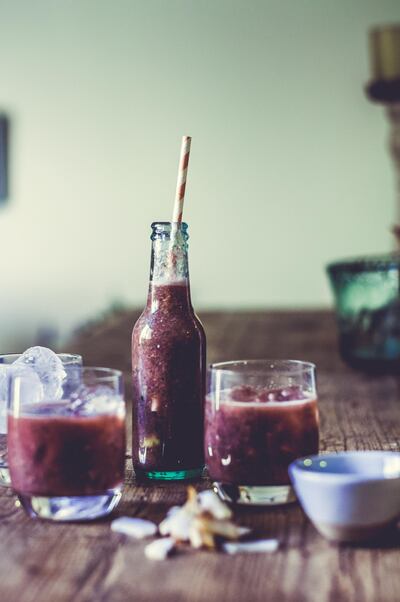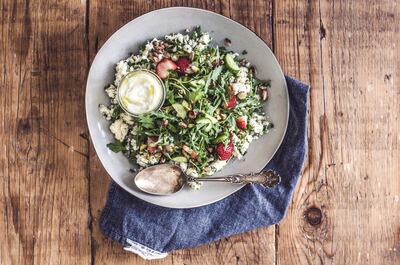You don't need us to tell you that the summer sun is officially raging. As the temperature soars, and we scurry from one air-conditioned building to the next battling the heat in between, one of the first things to take a hit is our hydration levels.
Being hydrated is, in very basic terms, essential to our mental and physical well-being. Our bodies are composed of about 50 to 60 per cent water, and bodily fluids play an important role in maintaining proper digestive function, absorbing and transporting nutrients around the body, regulating temperature and removing toxins and waste.
Drinking eight glasses of water a day has long been touted as the magic number for optimum hydration, but nutritionist, author and health writer Ian Marber says that this number should be increased to 12 glasses, or about 1.5 litres, in the UAE heat.
It’s not quite as simple as just chugging back as much as you can manage in a single sitting, though. “There is a limit to the amount of liquid that the body can absorb at once. For example, drink a litre of water rapidly and you can expect to be visiting the loo soon after and more than once,” Merber says. “The urine will likely be very pale in colour, which suggests that maximum hydration has been reached. Had the same amount of fluid been drunk over a sustained period of time, the body would have more opportunity to distribute and utilise it more efficiently.”
While that certainly makes sense, putting this advice into practice can sometimes feel like a real chore. The good news for the water-averse, though, is that in the battle against dehydration, diet can play a significant role.
There’s a strong case for eating a certain amount (about 20 per cent) of our fluids, because the water in food is absorbed more slowly than in liquids. Although the majority of fresh ingredients – even meat and fish – contain water, some are more effective than others. With that in mind, we’ve compiled a list of big hitters in the hydration stakes and come up with some delicious recipes that put them centre stage.
Tips for staying hydrated
1. Infuse water with fruit and herbs – try combinations such as strawberries and basil, grapefruit and thyme, and muddled cucumber and mint. Or, boil plenty of fresh, lightly crushed ginger in water and leave to steep for an hour or so. Cool completely and then dilute with sparkling water as you would a cordial. You can also freeze chilled ginger, lemon or mint tea in ice cube trays and use them to delicately flavour your water.

2. Get into the habit of drinking a large glass of water as soon as you wake up in the morning. Doing this will mean you start the day hydrated. It will also boost skin health and help to kick-start your metabolism.
3. Buy a reusable water bottle and get into the habit of carrying it around with you. Set yourself mini water-related goals, for example, aim to consume your first 500 millilitres before 11am. Drinking a glass of water before every meal is also a good habit to establish. After a while, sitting down to eat will act as a trigger, reminding you to drink up.
_______________
Read more:
Gourmet food at 35,000 feet: ideas for creating your own on-board meals
A fresh take on fruit and vegetables
A complete guide to Vietnamese food
_______________
Five hydrating ingredients you need to add to your diet
Watermelon
The clue is, of course, in the name. Consisting of more than 90 per cent water, a chilled slice of the juicy watermelon provides immediate refreshment. Take a few minutes to prepare an energising smoothie containing the fruit mixed with coconut water and chia seed (see recipe below), and you’ll not only feel hydrated, but tick several nutritional boxes at the same time. Chia seeds alone provide fibre and protein, and are a source of omega-3 fatty acids.
Cucumber
As well as soothing puffy eyes, adding crunch to salads and being an effective edible toy for teething babies, low-calorie cucumbers fight the good fight against dehydration, too. Often celebrated as the most hydrating of all water-rich vegetables, cucumbers make an excellent post-exercise snack, thanks to their restorative vitamins, minerals and salt. Try them juiced with apples and ginger, use to make raita or tzatziki, blitz for a chilled soup, or slice into ribbons and toss with toasted coconut, sliced red chilli, shallots and lime juice.
Strawberries
They triumph as the most hydrating of all berries, with higher levels of water than raspberries, blackberries and blueberries. Strawberries also contain a notable amount of potassium, which helps the body to maintain and regulate fluid levels. It’s worth thinking outside the box a little with strawberries; if they’re not quite at their peak, roasting them with a squeeze of lemon juice and a little sugar and salt will help intensify their flavour no end. Strawberries also work really well in savoury salads. Check out our recipe for inspiration.
Cauliflower
It’s perhaps not the most obviously hydrating ingredient on the list, but it is a worthy and nutritious one – 100g of cauliflower is packed with fibre, vitamins and minerals, including vitamins C and K, and delivers almost 60ml of water. Embrace the current trend for all things cauli-fied and use the low-calorie vegetable to make cauliflower rice, try it steamed and mashed instead of potatoes, or use the blended florets to form the base of a vegan pizza crust.
Milk and yogurt
Milk rates highly on the hydration index. As well as being made up primarily of water, it also contains protein, sugar, fat, vitamins and nutrients, all of which aid recovery from dehydration fast. Plain, unsweetened yogurt also has a surprisingly high water count, as well as being rich in protein and easy to digest.
RECIPES:
Watermelon, coconut and chia smoothie (Makes 4)
Prepare: 10 minutes
800g watermelon flesh, roughly chopped, plus extra wedges to serve (optional)
50ml coconut water
1 banana, roughly chopped
2 tbsp chia seeds
Toasted fresh coconut, to serve (optional)
Put the watermelon, coconut water and banana in a blender and blitz until smooth. Stir in the chia seeds and chill in the fridge.
Divide the smoothie between four ice-filled glasses and serve topped with toasted coconut, with the extra watermelon wedges on the side, if you like.

Strawberry, cucumber and rocket salad with feta-yogurt dressing and cauliflower rice
Serves 4
Prepare: 20 minutes
1 small head cauliflower, broken into florets
3 tbsp olive oil
Juice and zest of 1 lemon
½ bunch parsley, leaves picked and chopped
300g strawberries, hulled and halved
2 small UAE cucumbers, chopped
100g rocket
50g almonds, toasted
75g feta cheese
½ garlic clove
4 tbsp natural yogurt
Put the cauliflower florets in a blender and blitz until finely chopped. Tip into a bowl, drizzle with 2 tablespoons olive oil, the juice and zest of half the lemon and all the chopped parsley. Season generously and set aside.
Add the feta to a bowl and roughly mash with a fork. Stir in the yogurt, garlic and remaining lemon juice and zest, and the olive oil. Season.
Tip the cauliflower out onto a large plate or platter. Arrange the strawberries, cucumber and rocket onto top and scatter over the toasted almonds. Drizzle with a little of the feta-yogurt dressing and serve the extra on the side.







